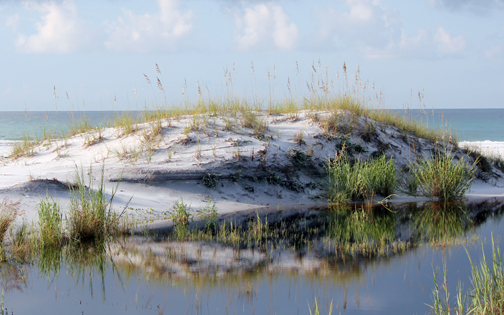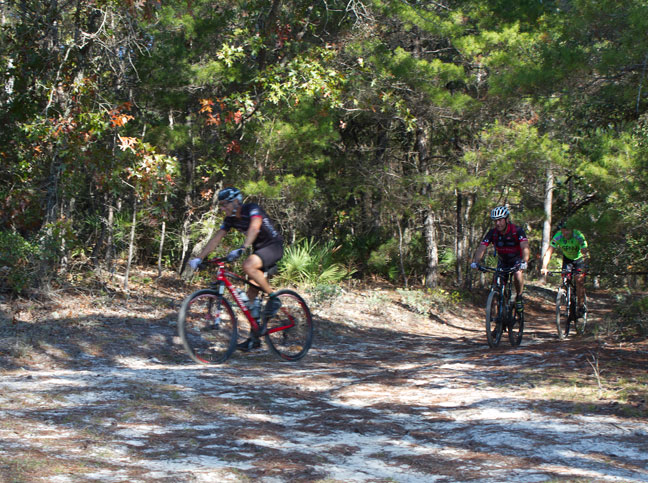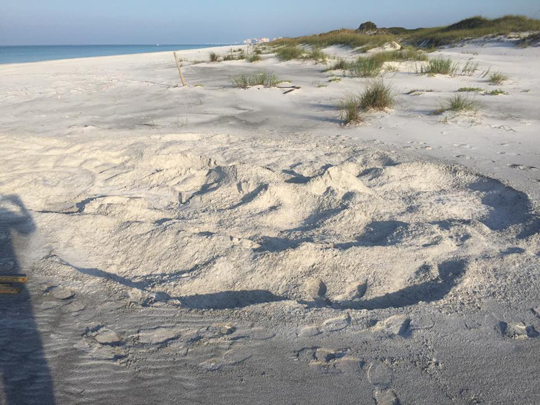
As our community grows, many residents and visitors continue to be in awe of the extraordinary amount of recreation land we have in South Walton county. However, some newcomers have no idea how we acquired such a vast and beautiful landscape enjoyed by many.
Topsail Hill Preserve State Park and Point Washington State Forest almost didn’t happen. Thanks to the support from organizations such as The Nature Conservancy, an energetic group of advocates from 4-Mile Village, local conservation group Beach To Bay Connection, and passionate Santa Rosa Beach residents thank goodness it did, and it came down to an earnest, last minute effort by Nature Conservancy purchasing 15,000 acres of land on the Walton County courthouse steps on May 19, 1992.
“Twenty-five years ago today Point Washington State Forest was purchased along with the first parcel of land at Topsail Preserve. May 19 should be a national holiday in South Walton. Imagine the forest as developed, there were people back in 1992 who did. The small but mighty community spent years making sure thousands of acres of our forest and state parks were not sold or given to the county or developers,” said Celeste Cobena, Santa Rosa Beach resident and conservation advocate.

The history of the Topsail Hill Preserve State Park reads like a Carl Hiassen novel. Savings and loan disasters, shady transactions, foreclosures, and local government opposition dot the trail to what would eventually become a beloved jewel for Walton county residents and visitors:
1925 – Alfred duPont purchases land in South Walton for $11/acre.
1936 – St. Joe Paper Company is formed. Holdings in Topsail total 21,000 acres including six miles of beachfront.
1981 – Jacob Belin, St. Joe CEO, proposes turning Topsail Hill property into “The playground of America,” proposing a golf course and marina.
1984 – St. Joe Paper puts Topsail Hill land on market.
1986 – William Michael Adkinson, a Panhandle native turned developer, then living in Texas, Keith Alan Cox, a London attorney, and their associates offer to buy 20,800 acres under the company name Development Group Inc. for $182 million from St. Joe Paper. At the time it was the most expensive real estate deal in Florida’s history. Their marketing report showed big plans for the land: a barge port, condos, hotels, golf courses, airport, schools, theme park, and more. A portion of the mortgage was held by St. Joe Paper.
1987 – Development Group fails to make payment. Loans from Texas based Vision Banc and Hill Financial Savings in Pennsylvania fail. St. Joe Paper forecloses and regains possession of 780 acres of beachfront. The remaining acres are put under management of Resolution Trust Corp., (RTC), (the agency created to clean up the savings and loan institution mess), handling the aftermath of the savings and loan crisis that encompassed several institutions nationwide.

1988 – Topsail Hill land is now comprised of approximately seven ownerships.
1989 – RTC files suit in U.S. District Court in Pensacola seeking foreclosure on the joint ventures’ Topsail holdings.
1990 – Florida Legislature passed of the landmark Preservation 2000 Act. This act anticipated the sale of $3 billion in bonds over a ten-year period, $300 million per year, from 1991 – 2000. The funds were to be given to the CARL program (50 percent), the Save Our Rivers programs of the five water management districts (30 percent), a newly-created Florida Communities Trust aimed at helping local governments (10 percent), 2.9 percent each to the Division of Recreation and Parks, the Florida Game and Fresh Water Fish Commission, and the Division of Forestry to purchase inholdings and additions to State Parks, Wildlife Management Areas and State Forests, respectively, and finally 1.3 percent for recreational trails.
1990 – 1991- The Land Acquisition Advisory Council (LAAC) acquires several parcels and transfers tracts to the Save Our Coast (SOC) and Conservation and Recreation Lands (CARL), state of Florida’s land buying program list.
1992 – 1994 – Nature Conservancy steps in with funding to purchase initial Topsail parcels and 15,000 acres of Pt. Washington State Forest from RTC on the Walton County courthouse steps. The Conservancy had been keeping a watchful eye on Topsail for close to a decade. Nature Conservancy sold it to the state through the Preservation 2000 land acquisition program.
1992 – The Board of Trustees of the Internal Improvement Trust Fund (Trustees) obtained title to the initial acquisition of Topsail’s 348.85 acres. The initial and subsequent acquisitions were funded through the CARL program. Subsequent acquisitions were funded through CARL program, and Preservation 2000 funds. Topsail was officially designated a state park.
1988-1992 Topsail Hill on the CARL (Conservation and Recreation Land) list ranked #2 for funding in 1992 – The primary management objective of the park is “the preservation of natural communities, significant physical features, and rare plant and animal species.” Secondary resource based recreation. “Extra care must be taken to minimize unnatural intrusions into the landscape.”
1996 – 1997 – TDC director Malcolm Patterson and Sandestin General Manger Jim Rester propose 3-100 car parking lots on beach at Topsail Hill Preserve- plan shelved due to community outcry.
1999-2004 – Several attempts by Noble House property owners (former owners of Cypress Dune subdivision) to gain an eastern access into Topsail Preserve for their property. This included a lawsuit against the state of Florida by the Noble House property owners in 1999.
2013 – Walton County commissioner Cindy Meadows, along with Walton County Tourist Development director Jim Bagby, and Cypress Dune homeowners meet with Florida Division of Recreation and Parks (DRP) to propose installing a neighborhood beach access inside Topsail Preserve State Park for the Cypress Dunes Subdivision. The proposed boardwalk would of been 1,650 linear ft.
Editors note: Preserving this conservation land continues to be challenging for supporters. Developers, and even local government continue attempts to acquire parcels within the boundaries of this beloved paradise. We must continue to advocate its preservation and be steadfast in its protection.
